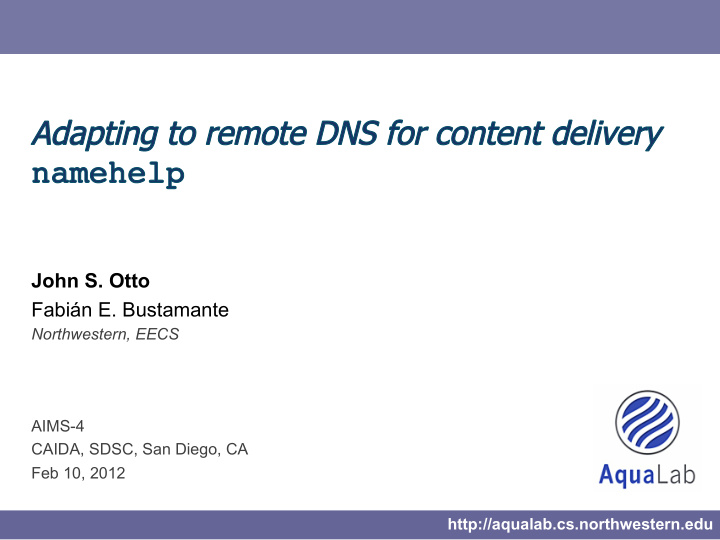



John S. Otto Fabián E. Bustamante Northwestern, EECS AIMS-4 CAIDA, SDSC, San Diego, CA Feb 10, 2012 http://aqualab.cs.northwestern.edu
CDNs direct web clients to nearby content replicas � Several motivations for using CDNs � – Performance, scalability, reliability Most popular sites use them � – 75% of top 1000 sites – 90% of pageviews to top 1000 sites Adapting to remote DNS for content delivery – namehelp � 2 Otto & Bustamante
CDNs use DNS to map clients to servers � – Assume proximity of client to DNS resolver Content Origin CDN Replica End Host CDN Replica Adapting to remote DNS for content delivery – namehelp � 3 Otto & Bustamante
CDNs use DNS to map clients to servers � – Assume proximity of client to DNS resolver Content Origin CDN Replica Local DNS End Host CDN Replica Adapting to remote DNS for content delivery – namehelp � 4 Otto & Bustamante
CDNs use DNS to map clients to servers � – Assume proximity of client to DNS resolver Content Origin CDN Replica Local DNS End Host CDN Replica Remote DNS services break this assumption Remote DNS We see 27% annual increase in their usage Adapting to remote DNS for content delivery – namehelp � 5 Otto & Bustamante
Can we maximize user benefits from both remote DNS and CDNs? Today… � Compare CDN redirections and end-to-end performance � Evaluate adoption of industry’s response � Present an end host solution � Adapting to remote DNS for content delivery – namehelp � 6 Otto & Bustamante
Remote DNS services yield radically different redirections � – Minimal overlap with those seen from the client From the client, “perfect information” Adapting to remote DNS for content delivery – namehelp � 7 Otto & Bustamante
Remote DNS services yield radically different redirections � – Minimal overlap with those seen from the client A good approximation 80% median overlap Adapting to remote DNS for content delivery – namehelp � 8 Otto & Bustamante
Remote DNS services yield radically different redirections � – Minimal overlap with those seen from the client 90% have no overlap Adapting to remote DNS for content delivery – namehelp � 9 Otto & Bustamante
Different redirections mean different performance � Adapting to remote DNS for content delivery – namehelp � 10 Otto & Bustamante
Different redirections mean different performance � 80% have <15% penalty Adapting to remote DNS for content delivery – namehelp � 11 Otto & Bustamante
Different redirections mean different performance � Top 20% have 200% penalty In median case, 65% penalty Adapting to remote DNS for content delivery – namehelp � 12 Otto & Bustamante
Resolver sends client’s subnet to CDN’s authoritative DNS � – Redirections are based directly on client’s location – DNS extension requires participation of DNS and CDN services Limited adoption to date � Conservative: Most from using Google services Adapting to remote DNS for content delivery – namehelp � 13 Otto & Bustamante
Forget them! Go for the end host � – Colocate client and resolver – Act as transparent DNS proxy – Obviate need for DNS or CDN cooperation Direct resolution � – Use recursive DNS to translate customer name to CDN – Directly query CDN for an improved redirection Learning by doing � – Local caching of CDN’s DNS server – avoid extra lookup – Only do direct lookup when it improves performance Adapting to remote DNS for content delivery – namehelp � 14 Otto & Bustamante
Focus on places where remote DNS affects performance � Industry solution has significant potential benefit � End host solution’s actual benefits are comparable � Relies on DNS and CDN adoption Potential benefit Adapting to remote DNS for content delivery – namehelp � 15 Otto & Bustamante
Focus on places where remote DNS affects performance � Industry solution has significant potential benefit � End host solution’s actual benefits are comparable � Actual benefit Adapting to remote DNS for content delivery – namehelp � 16 Otto & Bustamante
Focus on places where remote DNS affects performance � Industry solution has significant potential benefit � End host solution’s actual benefits are comparable � Within 16% of potential Adapting to remote DNS for content delivery – namehelp � 17 Otto & Bustamante
Focus on places where remote DNS affects performance � Industry solution has significant potential benefit � End host solution’s actual benefits are comparable � Largest improvement where penalty is worst Adapting to remote DNS for content delivery – namehelp � 18 Otto & Bustamante
Focus on places where remote DNS affects performance � Industry solution has significant potential benefit � End host solution’s actual benefits are comparable � Improves performance in 76% of locations And you can get this now! Adapting to remote DNS for content delivery – namehelp � 19 Otto & Bustamante
Working on browser-based and standalone versions � � More to come � – Selecting the best recursive DNS server – Deciding whether to use direct resolution technique Improve web performance for 76% of affected locations � Provide insight on DNS’s role in web performance � Questions? � Adapting to remote DNS for content delivery – namehelp � 20 Otto & Bustamante
Recommend
More recommend